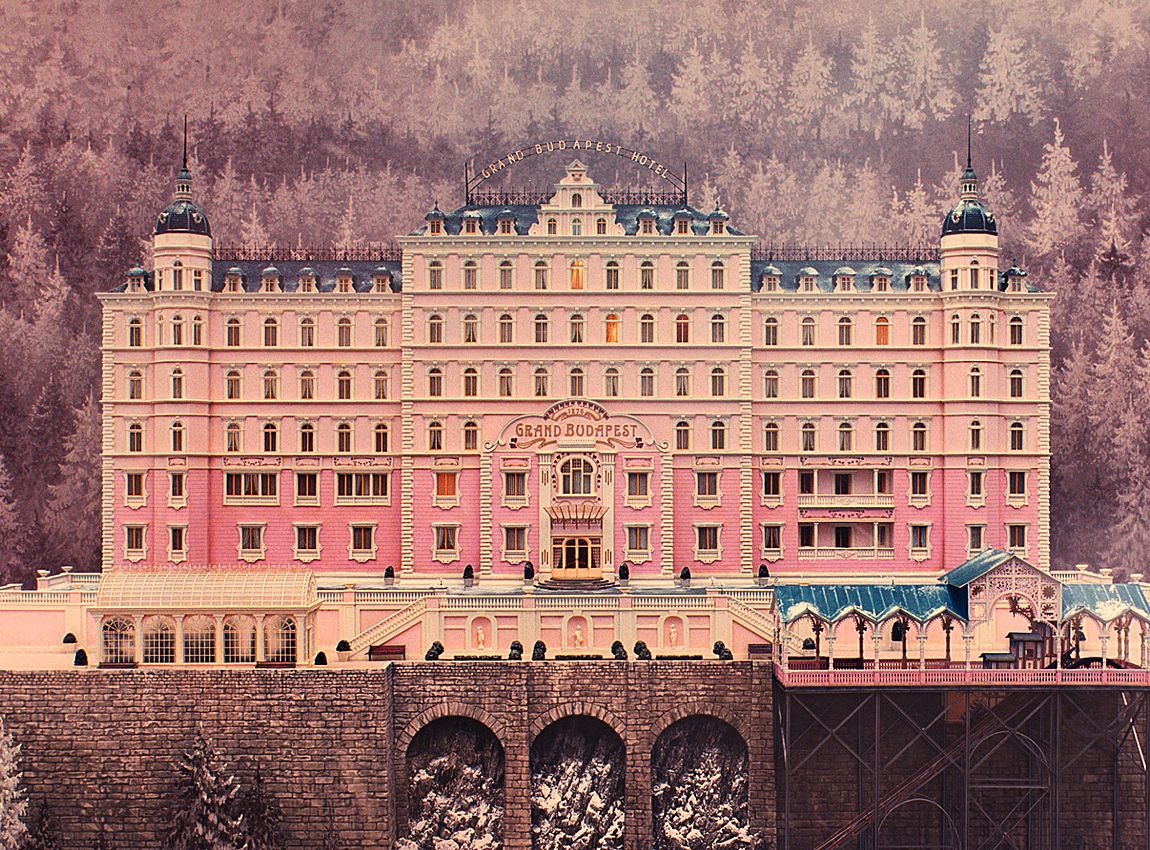Oscar Week: Trojan Brioche
Janet McAllister on Grand Budapest Hotel and how it tricks liberals into forgetting themselves
Halfway through The Grand Budapest Hotel, Ralph Fiennes as our hero Monsieur Gustave H. escapes from prison and is met outside its walls by his lobby boy protégé, Zero. Zero (Tony Revolori) has made zero preparations for his mentor’s fugitive flight. As this is a Wes Anderson film and Wes Anderson has a fondness for patterns, their exchange follows the three-strike arrangement familiar from fairytales and jokes:
– Where is the safe house? – There is no safe house.
Oh well, says M. Gustave, not to worry.
– Where are the disguises? – There are no disguises.
Oh well, says M. Gustave, we can manage.
– Where is the perfume? – There is no perfume.
You little fucker, says M. Gustave, and spits out the movie’s cruellest
speech to impress upon Zero that he has committed the unpardonable
sin.
It is not quite that M. Gustave favours style over substance, and prefers “L’Air du Panache” to shelter and clothing. It is that in this film, style itself has substance. One’s affection for one’s lover is expressed in one’s shade of nail polish. This film is serious about frivolity; it cares deeply about the shallows. It puts all its energy into skating over surfaces as lightly as possible – and it suggests we do the same.
More than cologne and cosmetics, the major motif of this ostensibly sweet, warm, comforting theme is cake. Not only does M. Gustave win friends and influence fellow prisoners by sharing cake with them, cake also successfully hides break-out tools, and it even breaks falls that would otherwise be fatal. Cake is no mere frippery, it is vital to plot, life and limb; and significantly, it seduces both characters and audiences alike.
What do these sweet non-nothings remind us of? Ah yes, the legend of Marie Antoinette. These echoes are not coincidental. Austrian writer Stefan Zweig who inspired Budapest once wrote a biography of the Austrian-French Queen, and Anderson’s friend Sofia Coppola directed a film about her. If you squint, the Budapest cakes – based on patisserie religieuses but decked out in mint green and rose pink instead of monastery brown – even look like fashionable 18th century dames with their hair piled high.
Marie Antoinette, trophy wife, symbol of insouciant decadence and thoughtless frivolousness, is an icon that Coppola, Anderson and their Hollywood patrician-pack polish up as aspiration as well as inspiration. But while Coppola attempted to recoup Antoinette’s reputation by pointing out that she never actually said her most infamous line, Anderson gleefully follows the Queen’s alleged command. In Budapest, whether his characters have bread or not, he lets them eat cake.
To call Anderson a conservative director is to earn sideways glances; his mannered aesthetic, while not strictly ground-breaking, is wonderfully considered and idiosyncratic. He draws attention to the artifice of film in a way that’s unusual and refreshing: punctuating action with elaborate “chapter” title cards; using the same coterie of actors across his films; letting said actors almost break character and smirk at us (“I’m being directed by Wes again, and it’s so much fun!”). The flourishes are not frenetic Liberace excess; they are tasteful, understated-dandy. Everything matches and is placed just so. The thoughtful, thorough attention to visual detail is soothingly trustworthy and excitingly delightful. Anderson is a more commercial Peter Greenaway, with Greenaway’s appetite for symmetry and architecture. Indeed, Budapest is a love letter to 'Big House' creations, leading us from hotel to prison, mansion, museum and monastery. Anderson places figures in landscape-large buildings, creating split-second patterns of washerwomen cleaning floor tiles, of gunfight sparks against a rose-lit ceiling. The visual shout-outs are clever: an unrecognisable Tilda Swinton camps about as a crone in a Klimt nymph dress (which is yet another Austrian reference – Budapest is set in an imaginary country named after Polish bison grass vodka but the Habsburgs would feel at home).
But while Anderson’s andante style is far from pedestrian, the politics of his oeuvre are unquestionably reactionary. He creates upper-class fantasy worlds, tinged – as aristo-philia often is – with nostalgia for a past golden age and regret for its decline and fall. Thus far, he has given us Rushmore’s boarding school and poor little rich Tenenbaums (Royal ones); self-indulgent underwater explorers and tourist brochures for the Indian raj. Even middle class Moonrise Kingdom fondly remembers the Boy Scouts movement and Anglican church music, those not-so-innocents of Empire. And in Anderson’s films, women exist only as love interests or cameos or both.
His style is so seductive, however, that liberals like myself fold away our principles for a while without even noticing. We find ourselves in a glazed cake daze at the end of all his movies, drool running down our chins, wanting more sweet visuals, more toothsome celluloid confectionary. These works aren’t run-of-the-mill or conformist cinema and we tend to assume that technical originality is a sign of disestablishmentarianism. Whereas, actually, Anderson is anti.
The Grand Budapest Hotel is The Bold and the Beautiful for arthouse-cinema snobs in that it continues the director’s grand project of inviting his audience to identify with the One Percent. The film – which Anderson wrote with Hugo Guinness, direct descendent of the “banking line” Guinnesses – suggests it is churlish and indeed, misleading, to describe M. Gustave as a mere hotel concierge. M Gustave presides over the Grand Budapest; nay, he is the Grand Budapest. His service to and from its blonde guests is his vocation and calling. This servant, the film suggests, is correct to tie his fortune to that of the bourgeoisie. The hotel and its systems are described as a “glimmer of civilisation” within a barbaric fascist world. Ah, thinks the audience, the film is against Nazis; we agree with it. But Anderson offers us aristocracy as the only real alternative to fascism. (The victorious, offstage Communists are dreary and let the Grand Budapest fall to wrack and ruin.)
Budapest nostalgically imagines an interwar ancien regime as a fantasy of luxury in reach for all. This is a kind Europe which takes in swathy refugees, like Zero, fleeing revolution (revolts, such a bore!), and a benign Europe which knows nothing of the brutal colonisation which precipitates such uprisings. Which is not to say Budapest doesn’t have its own cartoony violence – it does – but the caper tells us not to take it seriously.
It’s a vision of Europe apparently lifted straight from Stefan Zweig’s novels. Zweig is an ambiguous figure – a Jew who fled the Nazis but who apparently believed that artists and writers shouldn’t comment on politics. Independence from politics is always a delusion; someone who claims otherwise supports the political status quo, whether they realise it or not.
Perhaps more significantly, critics are divided about Zweig’s style – wonderfully light or hollowly superficial?
Anderson commends Zweig to us. Budapest lectures us on the importance of style, and Budapest’s own stylishness makes the lesson persuasive; it is its own example of what sheer panache can achieve. Stay on the surface with la crème de la crème. Cake and circuses for all.

